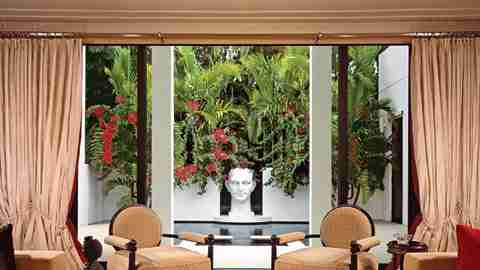The Art of Déco in Florida
View Slideshow

Everybody has a motto, a guiding principle on how to live—even if it's only "Eat, drink and be merry." Geoffrey Bradfield borrows his maxim from Oscar Wilde, who wrote that there is an art to living—that life itself is, in fact, "the first, the greatest, of the arts." It's a good motto for all interior designers, whose job it is, after all, to create the surroundings in which their clients can also live artfully. "Wilde's lines ring true for me," says Bradfield. "We create our interiors as a backdrop for our lifestyles, to enhance and illustrate the way we choose to live."
But what would the always quotable Wilde have said about the Art Déco–style house Bradfield has designed for financier George Mann in Palm Beach, Florida? Well, Wilde the playwright doubtless would have admired Bradfield's flair for the dramatic. When Mann bought the house, a spiral staircase was plopped down right in the middle of the living room, as ugly and awkward as "a military mustache," to use Bradfield's words, "all waxed and dour." The designer took a razor to that ungainly protuberance, replacing it with stairs along the wall of his own design. In an homage to those classics of Art Déco design—RKO's elegant black-and-white musicals of the 1930s—he constructed it out of tubular brushed steel and macassar ebony. "You can see Fred Astaire and Ginger Rogers coming down those stairs," he says—and you almost can.
More dramatic still is the enormous marble head of a man that stares into the living room from the other side of the swimming pool, as startling as the bust of Ozymandias in Shelley's poem. Sculpted by Enrique Mancini, the head is so heavy—3,200 pounds—that it had to be lowered into place by a crane. "We had to redesign the whole pool," says Mann, who shares the house with his wife, Carla. "Otherwise you would have banged your head on an overlay lip while you were swimming. We also discovered that the utility lines were exactly where we wanted to put the head. Water. Electricity. Everything. We had to move them all."
To add to the visual drama of that giant head, Bradfield put a black mirror behind it so it looks as if it is floating on the surface of the pool. "The two points of vision in the living room are the fireplace and the Mancini head," he says. "They're exactly opposite each other, totally aligned. One is in, one is out, and there's a visual synergy between the inside and the outside."
Mann's previous homes, in Toronto and Palm Beach, had leaned toward either formal French or informal Mediterranean, and the Toronto apartment he now lives in favors Biedermeier. But when he bought his new house, he knew it had to have a different look. "I'm impressed with the clean lines and freshness of Art Déco," he says. "It's more fun and a lot lighter than other styles. I picked Geoffrey to do this house because of his reputation for Art Déco and the beautiful work he had done in the past. I looked for Art Déco items by myself in Paris, but I saw so many things that I was confused. I told Geoffrey that we would have to go together, and he was able to organize the whole thing in one day."
"When good Americans die they go to Paris," said Wilde. But Bradfield and Mann did the opposite: They brought Paris to America. Almost everything—from the gilt fire screen in the living room to the wrought-iron-and-marble consoles in the entrance hall—was made in France. "What we have is a mixture of authentic pieces and reproductions," says Bradfield. "The great Art Déco pieces were very expensive and not meant for the masses. They're like cinematic sets of the '30s—glamorous, sensual and sophisticated."
"Glamorous, sensual and sophisticated" is a good description of the dining room. A mirrored wall reflects the courtyard and pool, while adjoining walls have a textured diamond pattern, on top of which are polished-steel tacks that sparkle like diamonds. Most clients like to think they have collaborated with their designers. Mann went one step further: He put those glittering tacks into the walls himself. "There were hundreds and hundreds of them," he says, "and it took me three days to put them all in." But a dining room that gleams and glows was worth a sore thumb.
What would Oscar Wilde, the aesthete, have said about a house so worldly and suave? Just open a book of Wilde quotations, and you'll have a likely answer—as well as a good motto for any designer: "I have the simplest of tastes," he said. "I am always satisfied with the best."